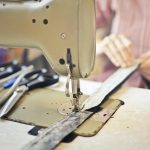When seeking heavy duty fabrics, mastering the art of selection is essential for ensuring satisfaction. With these 10 tips, you can confidently navigate the realm of rugged textiles.
From assessing durability to examining tear resistance, each tip serves as a valuable tool in your fabric selection arsenal.
By considering weight, strength, abrasion resistance, and more, you can make informed decisions that align with your specific needs.
Whether it's for industrial applications or outdoor gear, these tips will empower you to choose heavy duty fabrics with precision and expertise.
Key Takeaways
- Weigh the fabric to assess durability and strength
- Assess resistance to wear and tear, abrasion, tear strength, and tensile strength
- Subject heavy-duty fabrics to standardized tests like Martindale or Wyzenbeek
- Examine tear and puncture resistance at stress points like seams, pockets, and joints
Consider the Fabric's Weight
When choosing heavy duty fabrics, you should weigh the fabric to ensure it meets your needs for durability and strength. Fabric density and material composition are crucial factors to consider.
Fabric density refers to the closeness of the fibers in the fabric. A higher fabric density indicates a stronger and more durable fabric.
Material composition, on the other hand, refers to the type of fibers used in the fabric and their blend. Fabrics made from natural fibers like cotton or wool tend to be strong and durable, while synthetic fibers like polyester or nylon are also known for their strength and resilience.
When evaluating the weight of the fabric, consider the specific requirements of the end-use. For heavy duty applications such as industrial workwear or outdoor gear, a heavier weight fabric with high density and strong material composition would be ideal.
However, for applications requiring more flexibility or breathability, a lighter weight fabric may be more suitable.
Evaluate Durability and Strength
To ensure the durability and strength of heavy duty fabrics, you should carefully assess their resistance to wear and tear as well as their overall robustness. Consider factors such as abrasion resistance, tear strength, and tensile strength when evaluating the fabric's suitability for your specific needs.
Testing methods play a crucial role in evaluating durability and strength. Various standardized tests, such as Martindale or Wyzenbeek for abrasion resistance, can provide valuable insights into how well the fabric will hold up over time. It's also essential to consider the fabric's tear strength, which can be tested using methods like the Elmendorf tear test. Tensile strength, another critical factor, can be evaluated through testing methods like the grab test or the strip test.
Additionally, material sourcing plays a significant role in determining the durability and strength of heavy duty fabrics. High-quality raw materials and meticulous manufacturing processes can greatly enhance the fabric's overall robustness.
Assess Abrasion Resistance
Assess the abrasion resistance of heavy duty fabrics by subjecting them to standardized tests such as Martindale or Wyzenbeek, which provide valuable insights into the fabric's ability to withstand wear and tear over time. These tests simulate the fabric's performance in real-life situations, helping you make informed decisions.
When assessing abrasion resistance, consider the fabric construction. Fabrics with a tight weave or high thread count generally offer better abrasion resistance. Additionally, fabrics made from synthetic fibers like nylon or polyester often exhibit superior durability compared to natural fibers.
Understanding the fabric construction and how it relates to abrasion resistance will guide you in selecting the most suitable heavy-duty fabric for your specific needs.
Examine Tear and Puncture Resistance
When choosing heavy duty fabrics, it's important to examine tear and puncture resistance to ensure durability in stress points.
Consider the fabric's ability to withstand tears and punctures, especially in areas that are prone to high levels of stress.
This will help you select a fabric that can withstand the demands of heavy use and provide the longevity you need.
Strength in Stress Points
How can you ensure heavy duty fabrics have the necessary tear and puncture resistance for stress points?
When choosing heavy duty fabrics, focusing on reinforcing stress points is crucial for long lasting durability. Look for fabrics that have reinforced stitching and extra layers of material at stress points such as seams, pockets, and joints.
Additionally, consider fabrics that have been treated for enhanced tear and puncture resistance, such as those with added coatings or laminates. Evaluating the fabric's tear strength and puncture resistance through standardized testing methods can provide insight into its durability.
Look for fabrics with high tear strength, measured in pounds or newtons, and puncture resistance, measured in force required to puncture the fabric. This ensures that the fabric can withstand the rigors of heavy use and challenging environments.
Consider Fabric Durability
To ensure the durability of heavy duty fabrics, carefully examine their tear and puncture resistance, particularly at stress points such as seams, pockets, and joints. When considering fabric durability, it's essential to assess various factors that contribute to long-term resilience. Here's what to look for:
- Tear Resistance: Check for fabrics with a high tear strength to withstand sudden force or pressure without ripping.
- Puncture Resistance: Look for fabrics that offer strong resistance to punctures, making them suitable for rugged use.
- Fabric Flexibility: Opt for fabrics that maintain flexibility even under stress, preventing stiffness and potential cracking.
- Long-Term Durability: Choose fabrics known for their long-lasting performance, ensuring they can withstand wear and tear over extended periods.
Check for Water and Stain Resistance
Choose heavy duty fabrics with a high level of water and stain resistance to ensure longevity and easy maintenance. When selecting heavy duty fabrics, it's crucial to prioritize water and stain resistance, especially if the fabric will be exposed to potential spills, moisture, or outdoor elements.
Fabrics with advanced water and stain resistance technology repel liquids and prevent stains from setting in, making them easier to clean and maintain over time. This feature not only extends the lifespan of the fabric but also reduces the need for frequent washing or professional cleaning, saving you time and money in the long run.
Additionally, high water and stain resistance can often be achieved without sacrificing fabric breathability and comfort. Modern advancements in fabric technology allow for the creation of heavy duty fabrics that are both highly resistant to water and stains while still maintaining breathability and a comfortable feel. This ensures that you can enjoy the benefits of durable, long-lasting fabric without compromising on comfort, making it a win-win for practicality and comfort.
When assessing heavy duty fabrics, look for those specifically designed to resist water and stains without compromising on breathability and comfort for the best overall performance.
Review UV Resistance
When evaluating heavy-duty fabrics, consider the level of UV resistance they offer for long-term durability in outdoor settings. UV resistance is crucial for maintaining the fabric's strength, color, and overall integrity when exposed to sunlight. Understanding the impact of UV exposure on fabric longevity will help you make an informed decision when selecting heavy-duty fabrics for your outdoor needs.
Here are some important factors to consider when reviewing UV resistance:
- Importance of UV Resistance: UV rays can cause significant damage to fabrics over time, leading to fading, weakening of fibers, and deterioration of the material. Choosing fabrics with high UV resistance is essential for ensuring their longevity in outdoor environments.
- Testing Methods: Look for fabrics that have undergone rigorous UV resistance testing, such as ASTM International standards or AATCC methods. These tests evaluate the fabric's ability to withstand UV exposure and provide valuable insights into its long-term performance.
- Impact of UV Exposure: Understanding how UV exposure affects different types of fabrics, such as polyester, acrylic, or PVC, can help you select the most suitable material for your specific outdoor application.
- Long-Term Durability: Fabrics with superior UV resistance will maintain their strength, colorfastness, and overall quality, ensuring long-lasting performance in outdoor settings.
Look for Breathability and Comfort
When choosing heavy-duty fabrics, it's important to look for breathability and comfort.
Ensuring that the fabric allows air to flow through will help prevent overheating and discomfort.
Additionally, considering the weight of the fabric will contribute to both breathability and overall comfort.
Breathability Is Essential
Ensure that the heavy duty fabric you choose provides excellent breathability and comfort for extended wear. When choosing heavy duty fabrics, consider the following factors for optimal breathability and comfort:
- Moisture management: Look for fabrics that wick moisture away from the skin to keep you dry and comfortable, especially during intense physical activities.
- Airflow and temperature regulation: Opt for fabrics that allow for adequate airflow to prevent overheating and ensure proper temperature regulation, keeping you cool in warm conditions and warm in cold conditions.
- Comfort: Choose fabrics that are soft and gentle on the skin to prevent irritation and chafing, enhancing overall comfort during prolonged wear.
- Durability: Select heavy duty fabrics that maintain their breathability and comfort properties even after frequent use and washing, ensuring long-lasting performance.
Remember to prioritize breathability and comfort when selecting heavy duty fabrics to enhance your overall wearing experience.
Comfort Is a Priority
As you choose heavy duty fabrics, prioritize comfort by looking for breathability and comfort features that will enhance your wearing experience.
When selecting heavy duty fabrics, consider moisture management to keep you dry and comfortable. Fabrics with moisture-wicking properties draw sweat away from the skin, allowing it to evaporate quickly and preventing discomfort.
Additionally, look for fabrics that offer temperature regulation to keep you cool in warm conditions and warm in colder climates. Fabrics with temperature-regulating properties help maintain a comfortable body temperature by allowing heat and moisture to escape while retaining warmth when needed.
Prioritizing comfort through breathability, moisture management, and temperature regulation will ensure that the heavy duty fabric you choose provides the comfort you need for extended wear.
Consider Fabric Weight
To ensure comfort when choosing heavy duty fabrics, consider the fabric weight, focusing on breathability and comfort. Fabric thickness and material composition play a crucial role in determining the comfort level of heavy duty fabrics. Here are some key factors to consider:
- Fabric Thickness: Look for fabrics with a medium weight that provide a balance between durability and breathability.
- Material Composition: Opt for natural fibers like cotton or linen, which offer better breathability compared to synthetic materials.
- Breathability: Choose fabrics with a looser weave to allow air circulation, keeping you cool and comfortable.
- Comfort: Prioritize fabrics that are soft and gentle on the skin, ensuring maximum comfort even during extended wear.
Evaluate Colorfastness
Consider colorfastness when selecting heavy-duty fabrics to ensure long-lasting color vibrancy.
Colorfastness testing is crucial to determine how well a fabric retains its color when exposed to various conditions such as washing, light, and abrasion.
Different fabric dyeing techniques can affect colorfastness, with vat dyeing and yarn dyeing generally resulting in more colorfast fabrics compared to piece dyeing.
Vat dyeing involves immersing the fabric in dye, allowing for better penetration and color retention. Yarn dyeing, where yarns are dyed before weaving, also tends to produce fabrics with superior colorfastness.
On the other hand, piece dyeing, where the fabric is dyed after being woven, may result in less colorfastness as only the surface of the fabric is dyed.
To ensure the fabric maintains its color over time, look for heavy-duty fabrics that have undergone rigorous colorfastness testing and employ dyeing techniques known for producing long-lasting color vibrancy.
Consider Maintenance and Care
When maintaining heavy-duty fabrics, it's important to follow specific care instructions to preserve their durability and appearance for an extended period. Proper maintenance and care will ensure that your heavy-duty fabrics remain in top condition for a long time. Here are some essential maintenance tips and fabric care techniques to keep in mind:
- Regular Cleaning: Regularly vacuum or shake out heavy-duty fabrics to remove dust and debris. This prevents dirt from becoming embedded in the fabric fibers.
- Waterproofing Techniques: Use specialized waterproofing sprays or solutions to maintain the water-resistant properties of heavy-duty fabrics, especially for outdoor or marine applications.
- Stain Removal Methods: Familiarize yourself with the recommended stain removal methods for your specific heavy-duty fabric. Promptly treat stains using appropriate cleaning products to prevent them from setting.
- Professional Cleaning: For heavily soiled or large items, consider professional cleaning services to ensure thorough and safe maintenance of your heavy-duty fabrics.
Following these maintenance tips and fabric care techniques will help prolong the lifespan and functionality of your heavy-duty fabrics.
Check for Certifications and Standards
Ensure that heavy-duty fabrics you're considering meet relevant certifications and standards for quality and performance. When evaluating heavy-duty fabrics, it's crucial to check for industry-recognized certification standards.
Look for fabrics that have been tested and certified by reputable organizations to ensure they meet specific quality and performance requirements. Common certifications to look for include ISO (International Organization for Standardization) certifications, OEKO-TEX certification for textiles free from harmful substances, and ASTM International standards for fabric testing. These certifications indicate that the fabric has undergone rigorous testing and meets stringent quality and safety standards.
Additionally, consider fabrics that comply with industry regulations such as those set by government agencies or industry associations. Adhering to these regulations ensures that the fabric is manufactured and labeled in accordance with legal requirements, providing you with peace of mind regarding its quality and performance.
Frequently Asked Questions
How Do Heavy Duty Fabrics Compare in Terms of Their Impact on the Environment and Sustainability?
When comparing heavy duty fabrics, consider their environmental impact and sustainable manufacturing. Look for materials with certifications like Oeko-Tex or Global Organic Textile Standard. Choose fabrics made from recycled or natural fibers for eco-friendly options.
Are There Any Specific Regulations or Standards for Heavy Duty Fabrics in Different Industries or Applications?
When choosing heavy-duty fabrics, consider industry regulations and specific applications. Evaluate environmental impact, sustainability, and extreme weather performance. Look for standards that ensure quality and durability, while also promoting recycling and repurposing.
What Are Some Common Mistakes to Avoid When Choosing Heavy Duty Fabrics?
When choosing heavy duty fabrics, common mistakes can include overlooking fabric durability, neglecting proper maintenance, and selecting the wrong fabric for the intended use. Avoid these errors to ensure optimal performance and longevity.
Can Heavy Duty Fabrics Be Easily Recycled or Repurposed at the End of Their Lifespan?
Yes, heavy duty fabrics can be recycled or repurposed at the end of their lifespan. Recycling options include turning them into new textiles, while repurposing possibilities involve using them for various DIY projects or crafts.
How Do Heavy Duty Fabrics Perform in Extreme Weather Conditions, Such as Extreme Heat or Cold?
In extreme weather, heavy duty fabrics perform with exceptional durability and resilience. They withstand extreme heat and cold, ensuring long-lasting performance. Regular maintenance and cleaning are essential to uphold their quality and extend their lifespan.
- Can You Get Organza Wet? - April 23, 2024
- Why Is Organza so Popular? - April 23, 2024
- What Do You Wear With Organza? - April 23, 2024





